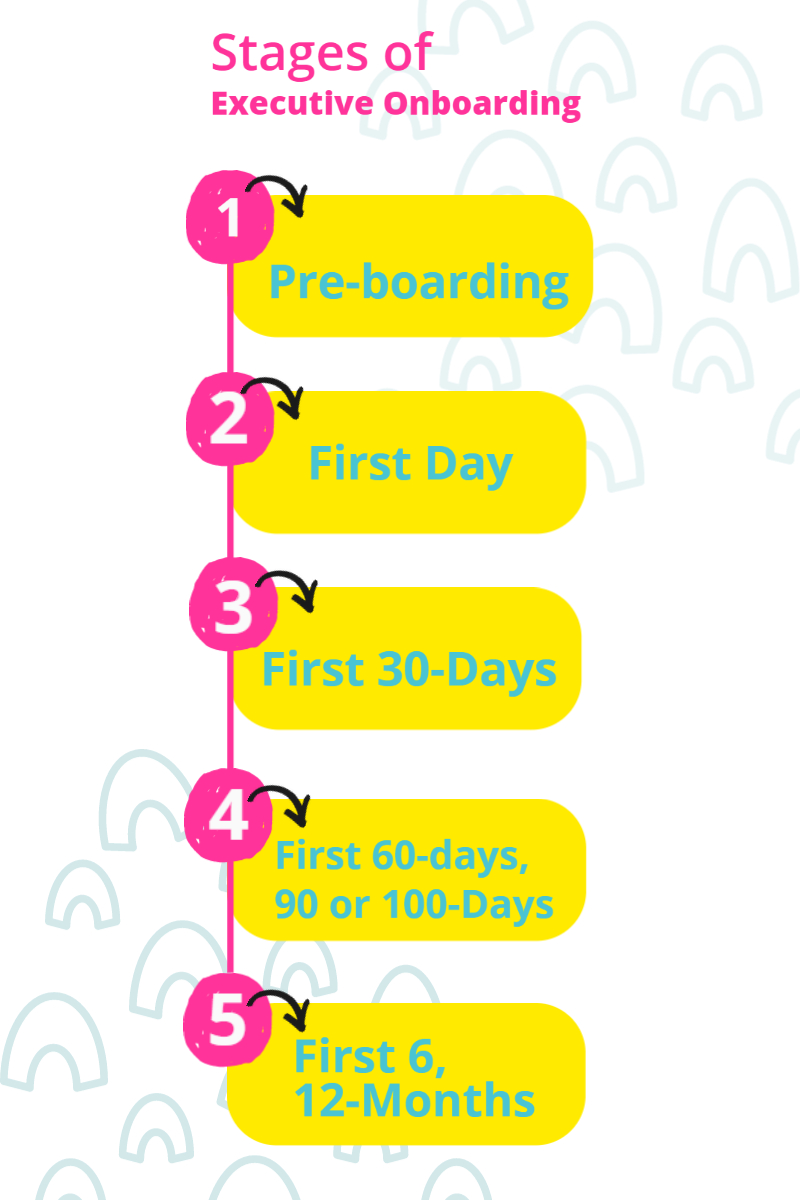The recruitment process for sourcing executives and senior leaders is complex and can at times be lengthy and costly. So much so that organisations typically seek the services of an external partner to lead the recruitment process. However, the biggest challenge for companies is in fact supporting the new leaders transition into the role.
Why is executive onboarding important?
Executive search is a rigorous process that requires specialised skills in sourcing and assessing talent. The goal is finding a candidate who is the very best fit for your business, now and into the future.
While all roles within an organisation are important, the impact of senior leader or executive failure is significant – their performance and decision making has a direct correlation with an organisation’s performance, not to mention the broader organisational impact on people, culture and values.
From the leader’s perspective, it is universally agreed that assuming a new role is one of the most challenging times in their career. It is often a knife edge where they either transition effectively into a role and establish their leadership, or, fail to build credibility and have others question their effectiveness.
The reality however is that given the demands and diligence of an executive search process, the overwhelming majority of new hires have the required skills and competencies to perform their roles well.
So why do new executives fail?
According to research from management consultancy firm McKinsey, three-quarters of executives consider themselves unprepared for a role because of inadequate onboarding processes.
What is executive onboarding?
We’re all familiar with onboarding – the process in which new hires are integrated into an organisation. This goes beyond standard employee orientation, for example completing employment paperwork, making introductions, and taking a tour of the office. Rather, it’s about creating a solid foundation for an incoming hire and building the right relationship between employer and employee, which sets both parties up for long-term success.
Executive onboarding has an added layer of complexity given the criticality of the role.
A recent study published in HBR suggests that organisations should in fact think of it as “integration” rather than onboarding. The study’s authors propose that well-integrated executives can build momentum early on and reduce the average amount of time to full performance by a third.
Furthermore, they suggest that new leaders need the greatest integration support for the following tasks: assuming operational leadership; taking charge of the team; aligning with stakeholders; engaging with the culture; and defining strategic intent.
Successful executive onboarding is a considered and intentional process that arms the new leader with the right resources, tools and time to perform in the role, while also creating a roadmap to ensure a smooth and timely leadership transition.
Stages of executive onboarding
A common approach for executive onboarding is breaking down tasks and goals based on a timeline with associated phases and steps. For example, pre-onboarding, followed by first 30, 60, 90-days, then 6 and 12-month plans.
These steps are intended as a guide; executive onboarding plans should be created based on the unique requirements of the role and your organisation.
We’re sharing some tips based on executive onboarding best practice.

Pre-boarding:
Congratulations, you have made an appointment! There’s a lot of thought and planning that needs to go into announcing the incoming senior leader – from who should be told and when, through to why this person is the right choice for the role.
Engaging relevant stakeholders is key, you should also think more broadly about what work may need to be done in shifting the company culture to accommodate the change in leadership.
Given lengthy notice periods for senior leaders there is plenty that can be done in the lead up to a new hire assuming a position, including organised meet-and-greets or introductory calls with key personnel (board members, leadership team, direct reports etc). These need to be frank conversations, to arm you with knowledge that will prepare you for day one and beyond.
As well as creating a transition and communication plan, there’s also the task of knowledge sharing, briefing the incoming executive on an organisation’s strategic intent as well as its history, culture and traditions.
For a senior executive, their first day in the role starts when they accept the position, not day-one in the office. Depending on the circumstances of the outgoing executive, you may also need to consider an interim leader as cover until the new appointee officially takes on the role.
First Day:
The majority of the groundwork should have been completed prior to the new hire starting their first day. For the incoming executive, that means knowing as much as possible about the organisation and the role. While there are a lot of expectations of a senior executive, the first day in the role (and the days following) should be focused on relationship building and importantly, establishing rapport with their team and wider employees.
According to HBR’s John Quelch, senior executives should be focused on the first-90 hours in a role. Quelch suggests that with all of the preparatory work completed, you will have heard almost everything you need to know by the end of your first 90 hours.
Depending on the seniority of the role, organisations may elect to conduct a town hall style meeting, gathering all employees together (face-to-face or remotely). While these types of meetings serve a purpose, engaging in one-to-one or one-to-many introductions can be more effective in creating deeper and lasting relationships.
First 30-Days:
The knowledge gained from the moment you accepted the position, through to first-day introductions and conversations, is part of wider research gathering, commonly referred to as learn and listen.
As part of this information gathering, and a popular approach to building relationships and engaging stakeholders, is conducting a roadshow where the incoming executive has face-to-face visits with as many people and locations as possible. It’s also an ideal time to be identifying your supporters, key members of your wider team and your high-potentials.
Skip-level meetings, where you meet with employees without their direct manager present, are also an effective tool in capturing insights. Similarly, focus groups with a diverse range of participants from throughout the organisation will give you a better idea of the culture and strengths of the organisation. Building a connection and opening a dialogue yield benefits in terms of credibility and trust.
Chances are a key part of your role is leadership of a direct team including support roles (i.e., EA), who are likely existing employees. It’s a delicate balance where you need to respect their commitment and relationship to the outgoing executive, while also making it clear that you are building a team for the future. Give them time and space to prove their value.
Leading, and being an integral member of, a high-performing team is demanding. Early on in the new appointee’s tenure you may also want to consider introducing tools to help integrate the new hire into the business. For example, customised team workshops and behavioural assessments to support the success of high-performing teams.
First 60-days, 90 or 100-Days:
There will be an expectation of action at some point, whether that’s noticeable change or the start of communicating the new hires key priorities and plans for their role and/or the wider organisation. It’s likely that key goals have already loosely been discussed and agreed upon with relevant stakeholders, for example with business leaders and/or the board. Or, simply signally your personal values that you’ll bring to the role.
You may also find it useful to commit to creating a role charter – defining your role, responsibilities and mission – and use this as a guide and reference point for all of your conversations, interactions and actions within your first 60-days in a role.
Another popular approach is the creation of a 100-day plan as a roadmap for outlining your goals and success measures in the role. Breaking this down into monthly markers makes the task more manageable.
As well as building your presence within the organisation, there’s also the day-to-day operational elements of your role that need to be managed. It can be a difficult balancing act, taking leadership of an organisation’s culture while also being responsible for tactical execution.
From the executive’s perspective, this initial period in a new role can be incredibly demanding, both professionally and personally. And this extends to their wider family who are supporting them in the transition. It is important for an organisation to be mindful of this and watch for signs of stress and burnout.
First 6, 12-Months:
Post 100-days in the role is the time for growth, reflection and assessment. This doesn’t have to include transformative change, but rather consider what small wins you can make that build engagement and trust, while also contributing to overall business performance.
Within this timeframe will also be some type of performance check-in based on previously agreed goals or KPIs, possibly including a 360-degree assessment that provides more meaningful feedback.
Regardless of whether the new hire is an existing leader or assuming a leadership role for the first time, leadership development is an ongoing process. Don’t expect your new hire to have all of the skills required to excel in a role. It is important to create a tailored professional development plan for business leaders to help build executive presence.
Creating an executive onboarding checklist
An executive onboarding checklist is a tool used to ensure that all necessary steps are taken during the onboarding process for a new executive. The checklist typically includes a series of tasks, activities, and milestones that need to be completed to effectively onboard the executive into an organisation.
As a general guide, an executive onboarding checklist may include:
1. Timing and communication of the announcement of an appointment, both internally and externally.
2. Creating a transition plan including 30, 60, 90-day plans.
3. Introduction to key stakeholders and team, with a focus on relationship building.
4. Orientation to the organisation including briefing material relevant to the role.
5. Clarify expectations and goals (employer and employee), and creation of an action plan.
6. Assign an executive sponsor, mentor or coach as a key point of contact.
7. Ongoing training and leadership development programme.
8. Performance and leadership review with feedback (performance objectives or KPIs agreed in advance).
9. Ongoing support to help the executive acclimate to their new role and responsibilities.
10. Celebrate and reward success; celebrate successes along the way, both big and small.
What else to consider
Additional tips for tailoring the onboarding checklist to the specific needs of the new hire and the organisation.

Transition of First-Time Executive:
If you are promoting from within your organisation or have appointed someone externally who is new to an executive role, you may want to consider what additional support can be offered to help with their transition.
There is an element of social isolation to a senior role, particularly for a first-time executive or CEO. Options may include for example executive coaching, support to build a high-performing team, mentoring or creating an informal relationship with a board member.

Remote Working:
Given that the key objective in executive onboarding is establishing a presence, this can be a challenging task in remote working environments. Leadership transparency is particularly important in remote first organisations. You may need to consider scheduling all of company meetings or briefings, as well as implementing effective employee feedback mechanisms.
Create A Stakeholder Map:
Given the criticality of the process and the broad span of influence of a senior role, it is likely that the executive onboarding process will be led by the CEO or board chair, alongside the senior HR leader, and possibly assigning a board member as an ongoing mentor.
It will also heavily involve internal communication teams, other executive leaders, and possibly the outgoing executive. It is vital that all parties are aligned in the intent and approach of an executive transition, this includes existing leadership teams, the board and the incoming executive. Creating a stakeholder map – identifying key stakeholders and outlining their relationships – can be a useful reference tool.
Final thoughts
Reflect on the time, energy and effort that was put into an executive search process – from sourcing the right talent through to assessing fit and finally, securing the right candidate. Now consider how much time is spent on supporting a successful executive in their transition to a new role. With the right planning and following a structured, highly supportive onboarding process you will position your new hires for greater success.
Need help?
Decipher Group are industry experts in the recruitment of executive, c-suite level professionals, and governance leaders for New Zealand and Australian businesses. We’ve been connecting talented people to exciting opportunities for 15 years. Let’s talk.
The Decipher Team
To stay on top of current recruitment trends and technologies follow Decipher Group on LinkedIn.
People Also Ask
A short Q&A with our team on related questions that people commonly search for on Google.
What are the timelines for executive onboarding?
Executive onboarding can be broadly classified by key milestones or stage gates that commence the moment a candidate accepts a position.
As a general guideline these include pre-boarding, the time prior to commencing in the role, followed by a set of stages once the executive officially begins in the role, typically classified as the first 30, 60, 90-days, up to 6 and 12-months.
Realistically, an executive role is a continual process of evolution and iteration. Following a structured and thoughtful onboarding process lays the foundation for future success in a role.
Who is responsible for executive onboarding?
Roles and responsibilities for executive onboarding can vary depending on the organisation and role. Given the seniority of the role, it will likely include the senior HR lead and the reporting lead (for example, the CEO and/or board).
Successful executive onboarding requires a collaborative effort between various stakeholders. The process should be well-planned and tailored to the individual needs of the executive to ensure a smooth transition into the organisation and to maximise their chances of success.
How to tailor an executive onboarding checklist to an organisation
Customising an executive onboarding checklist involves tailoring the checklist to the specific needs, culture, and values of the organisation, with consideration also given to the operating and ownership model.
Some key steps to follow include understanding the organisation’s culture and values; identifying the executive’s specific goals and responsibilities; defining the onboarding timeline; aligning the onboarding process with the organisation’s goals; and incorporating feedback from key stakeholders.








